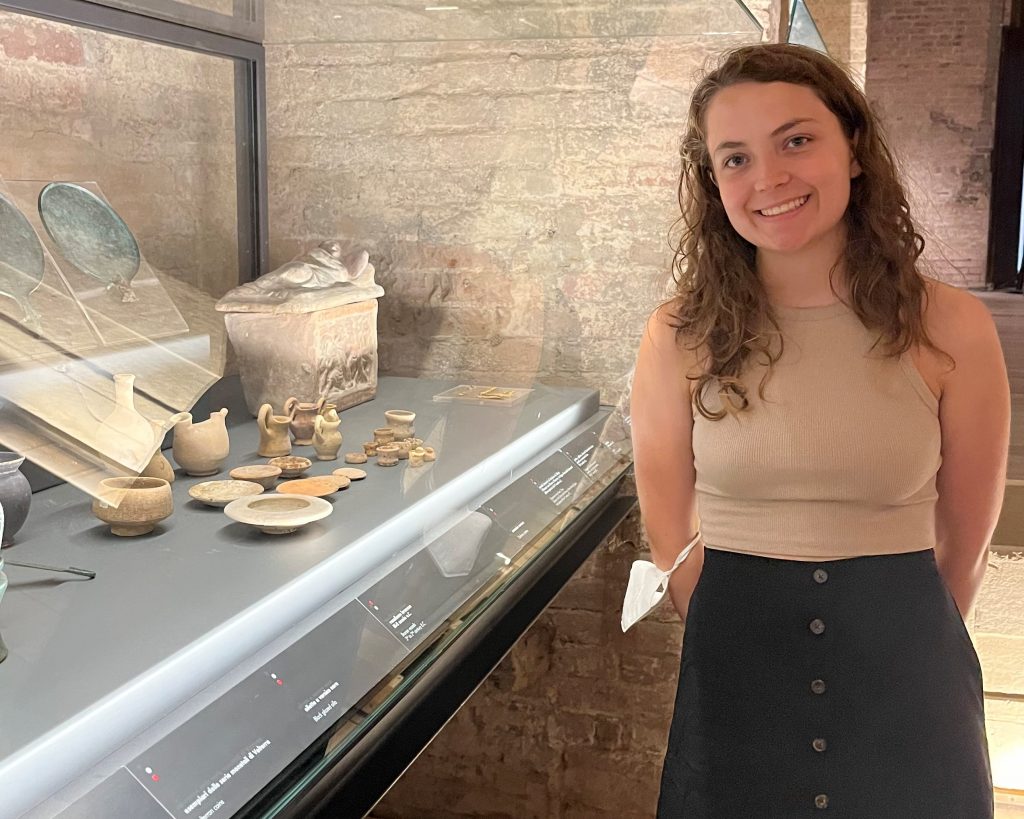
Brooke Cammann (Art History; Chemistry) fell in love with Italian art history as a first-year student in the SUNY New Paltz Honors Program, but it took until 2022 for her to fully capitalize on that interest with an international research experience.
“I saw a flyer on studying art history in Italy, and I was immediately intrigued,” said Cammann, who hails from Croton-on-Hudson, New York. “After doing my own research, I learned that you could pursue a career in conservation with an art history degree. For three years, I waited to study abroad because I knew Italy would be the place to pursue art conservation.”
Cammann had developed a fascination for this period after taking a virtual study abroad course led by Associate Professor Keely Heuer, who has been a mentor for much of her time at the College. Heuer helped her access a Summer Undergraduate Research Experience grant, and thanks to support from that grant and another from the Etruscan Foundation, she embarked on a one-of-a-kind applied art history and archeological research project in the small Italian village of Vescovado.
She was part of a team of undergraduate students from different universities working at archaeological site Poggio Civitate. Working under one of the most renowned Etruscologists in the world, Professor Anthony Tuck of the University of Massachusetts at Amherst, the student scholars undertook an excavation of ancient bronze artifacts, such as terracotta tiles, pottery, plaster, and bone.
Four weeks prior, she ventured around Italy’s museums and archaelogical sites on her own to familiarize herself with ancient Etruscan, Greek, and Italic bronze items ranging from large-scale sculpture to hand-held mirrors.
“There’s not really a chance to study a lot about conservation as an undergraduate student,” said Cammann, “and having the chance to learn more about it, especially the history of it, was really fascinating to me.”
Cammann zeroed in on examining bronze objects from the Etruscan era, an ancient historical period dating to nearly 3,000 years ago.
She explored how ancient bronze objects, which have been uncovered in Italy since the late Middle Ages/early Renaissance until the present day, have been treated by restorers and conservationists over the centuries. As a future conservator herself, she wanted to understand how practices changed over time, not only due to technological advances but also to shifting ideas about how antiquities should be handled and displayed.
To understand what modern conservators do, Cammann realized that she would need to gain first-hand experience at an archaeological site after learning about ancient Italian bronzes and their treatment in general in her travels and through reading secondary source material.
“Contextually, it’s been really helpful, just to be able to see not only what the objects look like, but where they came from,” she said. “Seeing something in the museum in the U.S., you see it only in a specialized manner as an exhibit, whereas here, it’s just so loved and appreciated.”
Digging ahead

While Cammann was on the other side of the Atlantic, New Paltz was never far from her sights.
She was joined on her Italian trip by Heuer, who served as her project advisor on the archaeological research.
“I’m so proud of Brooke to see how she has traveled for weeks on end,” said Heuer. “She has handled this like a pro.”
Heuer shared her knowledge and experience in the area, guiding Cammann through some of her favorite locations for Etruscan artifacts in the small cities of Tarquinia and Cerveteri. Both feature famous cemeteries where you can go inside the ancient tombs.
For this two-person team, the roots of this summer’s project can be traced to research they conducted together at the Metropolitan Museum of Art, where Heuer serves as a fellow. They studied Greek, Etruscan, and Roman galleries together so Cammann could get a sense of the kinds of objects she would be looking to excavate in Italy.
“There is nothing as exhilarating as teaching students on-site, so being able to show Brooke some of my favorite locations was especially meaningful to me as an educator,” said Heuer.
Cammann found that her experience in Italy solidified her future plans.
“My research this summer has assured me that conservation is what I want to study in graduate school,” she said. “It wasn’t until this summer that I was able to study conservation directly, which allowed me to explore my interest in greater depth.”
Click here for more information on New Paltz’s Department of Art History

